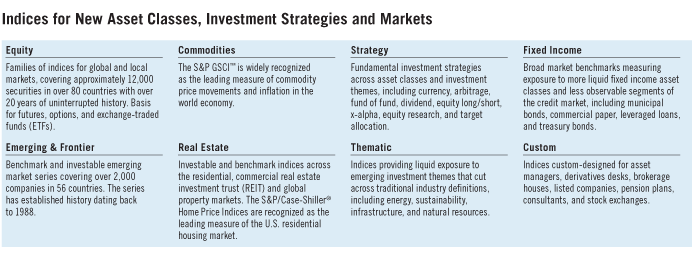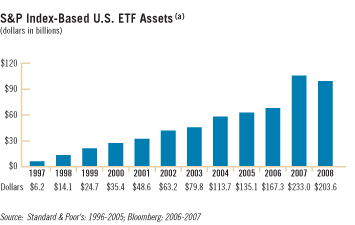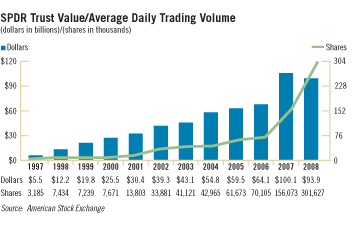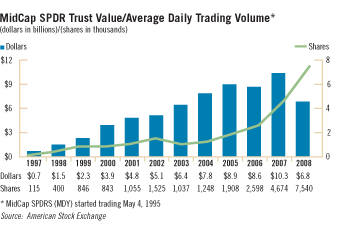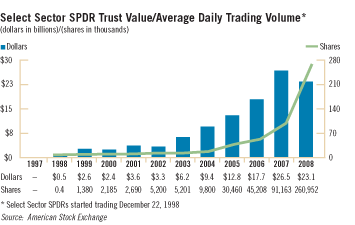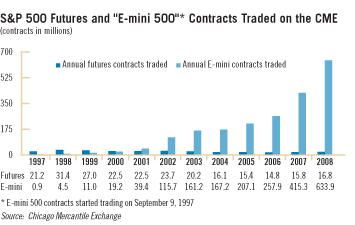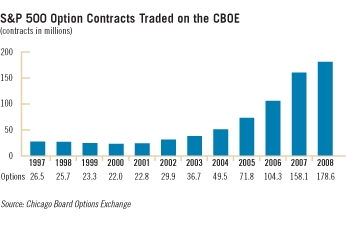
Index Services:
Providing an S&P Index for Every Type of Investment
Standard & Poor’s Index Services is the world’s foremost provider of stock market indices, offering a wide variety of investable and benchmark indices that meet an array of investor needs. Standard & Poor’s broad-based indices provide expansive access to the financial marketplace while its narrow-based indices give investors a greater ability to diversify portfolios. Partnerships with major exchanges throughout the world have resulted in enhanced investment choices and solutions for both retail investors and institutions alike.
Standard & Poor’s flagship index series, including the S&P 500 and the S&P Global 1200, are world-renowned as investable, transparent, and replicable offerings designed to serve as proxies for the different markets they measure.
In 2008, over $1.7 trillion in investable assets was directly tied to Standard & Poor's indices and $5.1 trillion was benchmarked to S&P indices
Culture of Index Innovation
Standard & Poor’s has a long history of creating indices that measure constantly evolving markets. New indices include:
- S&P Credit Default Swap (CDS) Indices reflect the credit default swap market for U.S. corporate credits. These indices increase transparency for market participants and offer insight into the performance of the U.S. CDS marketplace, including the investment-grade and high-yield markets. The S&P 100 CDS Index, the first CDS index based on an equity index, makes it easier to compare the performance of stocks and the $57 trillion1 CDS market.
- S&P VIX Futures Index Series is a suite of investable indices offering directional exposure to volatility through publicly-traded futures markets. Developed in cooperation with the Chicago Board Options Exchange (CBOE), the indices model returns from a long VIX futures position that is rolled continuously throughout the period between futures expiration dates.
- S&P U.S. Commercial Paper Index is a broad-based index designed to serve the investment community’s need for a benchmark representing U.S. commercial paper which is a widely-held investment among money market funds and other short-term investors. This index is the first of its type to be offered by a major index provider.
- S&P Risk Control Index Series enables investors to target and control the level of risk in an underlying S&P index. Standard & Poor’s is the first independent index provider to make volatility-targeting indices widely available to investors.
- S&P Target Date Index Series is comprised of nine multi-asset class indices, each corresponding to a particular target retirement date. Each index is fully investable, with varying levels of exposure to equities and fixed income. This index series is innovative, in that asset class exposures are driven by a survey of large fund management companies that offer target date products.
(1) Bank of International Settlement, notional outstanding at month-end June 2008
How S&P Index Products and Services Generate Revenue Investment vehicles such as ETFs, which are based on Standard & Poor’s indices and generate revenue through fees based on assets in underlying funds Index-related licensing fees, which are either annual fees based on assets under management or flat fees for over-the-counter (OTC) derivatives and retail structured products Data subscriptions, which support index product management, portfolio analytics, and research Listed derivatives, which generate royalties based on trading volumes of derivatives contracts listed on the Chicago Mercantile Exchange, Chicago Board Options Exchange, Australian Securities Exchange, Montreal Exchange, Korea Exchange, and other exchanges |
Record-Level ETFs Linked to S&P Indices
Exchange-traded funds (ETFs), which represent share ownership of an index fund but trade like shares of stocks, have become some of the most popular and actively-traded securities on stock markets around the world. Standard & Poor’s has been at the forefront of ETF development since the launch of the S&P 500 SPDR (Standard & Poor’s Depositary Receipts) in 1993, the S&P MidCap SPDR in 1995, and the Select SPDRs in 1998. 59 new ETFs linked to S&P indices were launched in 2008 (40 listed in the U.S. and 19 listed on international exchanges). Assets in the over 203 listed ETFs linked to S&P indices reached $203.6 billion at year-end 2008, led by the SPDR S&P 500 ETF, the largest ETF in the world.
Futures and options volume linked to indices continues to grow. Trading in E-mini S&P 500 futures at the Chicago Mercantile Exchange (CME) reached a record 633.9 million contracts in 2008, up 52.6% compared to 2007. Trading in S&P 500 options at the Chicago Board Options Exchange (CBOE) reached a record 178.6 million contracts in 2008, up 13.0% from 2007. New instruments such as options on VIX, a measure of volatility of the S&P 500, and weekly options linked to the S&P 500 and S&P 100, continue to expand the range of products linked to Standard & Poor’s indices.
| (a) | 1996-2005 represents assets under management from SPDRs, iShares, iUnits, S-tracks ASX, Rydex and Lyxor (MIB). 2006-2008 includes all “other” S&P-based ETF assets ($6.1 billion, $5.4 billion and $9.5 billion, respectively). Examples of “other” include: VXF (Vanguard Extended Market ETF), SDS (UltraShort S&P 500 ProShares), and IPRV (LN iShares S&P Listed Private Equity) |
